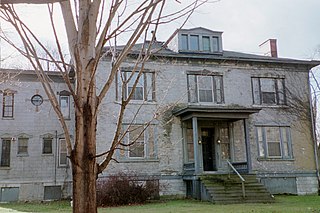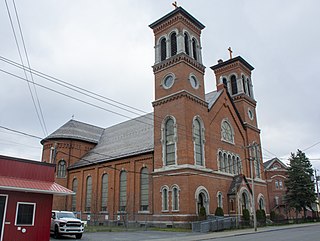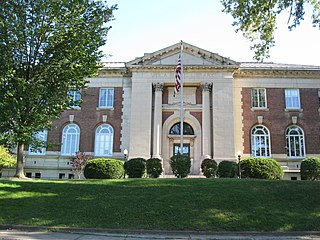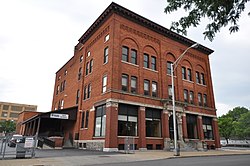
Utica is a city in the Mohawk Valley and the county seat of Oneida County, New York, United States. The tenth-most-populous city and sixth-most populous metro area in New York, its population was 62,235 in the 2010 U.S. census. Located on the Mohawk River at the foot of the Adirondack Mountains, it is approximately 95 miles west-northwest of Albany, 55 mi (89 km) east of Syracuse and 240 mi (386 km) northwest of New York City. Utica and the nearby city of Rome anchor the Utica–Rome Metropolitan Statistical Area comprising all of Oneida and Herkimer Counties.

The Munson-Williams-Proctor Arts Institute (MWPAI) is a regional fine arts center founded in 1919 and located in Utica, New York. The institute has three program divisions:

Fulton Ferry is a small area adjacent to Dumbo in the New York City borough of Brooklyn. The neighborhood is named for the Fulton Ferry, a prominent ferry line that crossed the East River between Manhattan and Brooklyn, and is also the name of the ferry slip on the Brooklyn side. The neighborhood is part of Brooklyn Community District 2.

The Utica Psychiatric Center, also known as Utica State Hospital, opened in Utica on January 16, 1843. It was New York's first state-run facility designed to care for the mentally ill, and one of the first such institutions in the United States. It was originally called the New York State Lunatic Asylum at Utica. The Greek Revival structure was designed by Captain William Clarke and its construction was funded by the state and by contributions from Utica residents.

Thendara is a hamlet and census-designated place (CDP) in Herkimer County, New York, United States. Thendara is located in the Adirondack Park, in the southern part of the town of Webb, west of Old Forge on Route 28.

The Boehlert Transportation Center at Union Station is a train station served by Amtrak and the Adirondack Scenic Railroad in Utica, New York. It is owned by Oneida County, and named for retired U.S. Rep. Sherwood Boehlert, R-New Hartford.

The Roscoe Conkling House is a historic house at 3 Rutger Park in Utica, New York, USA. A National Historic Landmark, it was the home of Roscoe Conkling (1829–1888), a powerful and controversial politician. He is responsible, perhaps, for the angry, political atmosphere that led to the assassination of U.S. President James Garfield.
Philip Hooker was an American architect from Albany, New York known for Hyde Hall, the facade of the Hamilton College Chapel, The Albany Academy, Albany City Hall, and the original New York State Capitol building.

St. Joseph's Church, also known as St. Joseph & St. Patrick Church, is a historic Roman Catholic church complex at 704-708 Columbia Street in Utica, Oneida County, New York. The complex consists of the church, St. Joseph's Parochial School (1885), St. Joseph's Parochial Residence (1906), and Parish Convent building (1891).

Utica Armory is a historic National Guard armory building located in Utica in Oneida County, New York. It is a structural steel structure with brick curtain walls built in 1930 for Troop A, 121st Cavalry, and designed by State architect William Haugaard.

Utica Public Library is a historic library building located in Utica in Oneida County, New York. It is a rectangular five story Neoclassical style structure, constructed of New Haven brick on a limestone foundation. It features a central pedimented pavilion with Corinthian order columns. It was designed in 1903 by Arthur C. Jackson of Carrère and Hastings.

Gen. John G. Weaver House is a historic home located at Utica in Oneida County, New York. It was built about 1815 and is a massive 2-story, brick, hip roofed double pile building in the Federal style. It is composed of a 2-story, five-by-four-bay rectangular main block, with a 2-story, gable-roofed rear wing. It is believed that the home was designed by Philip Hooker or someone strongly influenced by his work.

Byington Mill , also known as the J. A. Firsching & Son Building, is a historic knitting mill located at Utica in Oneida County, New York.

Doyle Hardware Building is a historic factory building located at 330 Main St in Utica in Oneida County, New York. It was built in three sections between 1881 and 1901. The entire four story complex is approximately 100 feet by 260 feet with 82,000 square feet of space. It was a work of Utica architect Frederick H. Gouge.

Hurd & Fitzgerald Building, also known as the Hurd Sales Company, is a historic factory building located at Utica in Oneida County, New York. It was built in 1911 and is a five-story, rectangular brick building built for a shoe and rubber goods manufacturer.

Holland Patent station is a historic train station located at Holland Patent in Oneida County, New York. It was built in 1890 and is a one-story, rectangular, wood frame building sheathed in board-and-batten siding. It was built by the Utica and Black River Railroad, later acquired by New York Central. It was used until 1960 and now the line is used by the Adirondack Scenic Railroad.

The John C. Hieber Building is a historic commercial building located at Utica in Oneida County, New York.

Utica Parks and Parkway Historic District is a national historic district located at Utica in Oneida County, New York. It consists of four contributing historic elements: a historic right-of-way known as the Memorial Parkway and the three large parks it connects: Roscoe Conkling Park, F.T. Proctor Park, and T.R. Proctor Park. The district includes seven contributing buildings, three contributing sites, 26 contributing structures, and five contributing objects. The park and parkway system was designed between 1908 and 1914 by the firm of Olmsted Brothers Landscape Associates, headed by Frederick Law Olmsted, Jr. The Utica Zoo is located in Roscoe Conkling Park.
Frederick Hamilton Gouge was an American architect practicing in Utica, New York.
This is a timeline and chronology of the history of Brooklyn, New York. Brooklyn is the most populous of New York City's boroughs, and was settled in 1646.





















